Each January, Kalibo and Boracay Island host the Ati-Atihan Festival. It’s a stunning mix of devotion to Santo Niño and Ati culture. The week-long event transforms streets with dance, music, and color. It’s a feast for the senses and a deep cultural dive. Known for lively parades and beats, it showcases Filipino heritage. It captures the essence of Filipino joy and faith. The festival is perfect for cultural enthusiasts and curious tourists. It’s a unique event, full of color and rhythm. It celebrates the rich history and vibrant traditions of the Philippines.
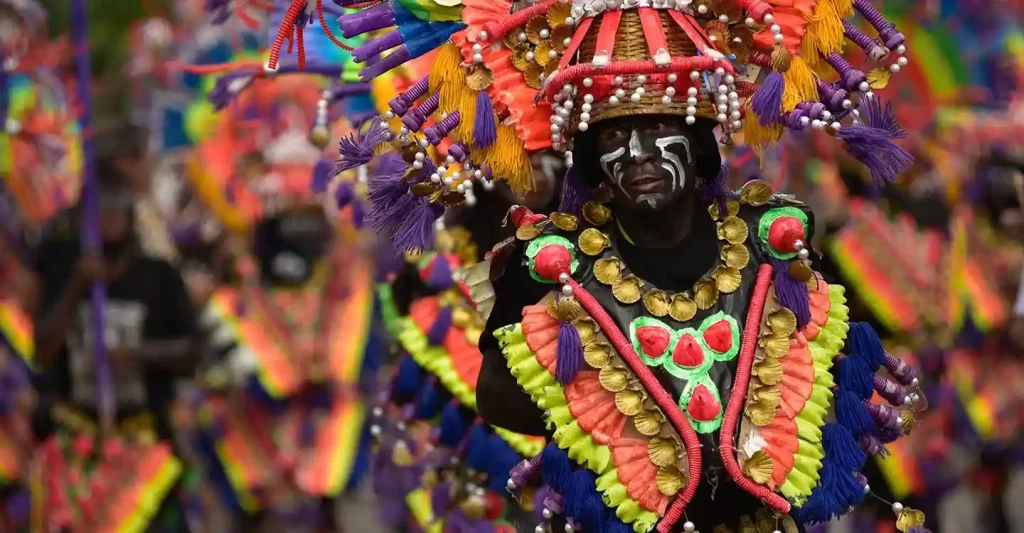
Unveiling the Ati Atihan Festival
The Ati-Atihan Festival celebrated every 3rd week of January, is a unique cultural spectacle. Named in honor of the indigenous Ati tribe, this festival commemorates the original settlers of Panay Island and venerates the Santo Niño, the infant Jesus. The name ‘Ati-Atihan’ translates to ’emulate the Ati people’, reflecting the festival’s homage to indigenous culture and its significant religious aspect dedicated to the Santo Niño. Known throughout the Philippines, Ati-Atihan is also dubbed “The Mother of all Philippine Festivals,” rooted in the ancient festivities of pre-colonial Filipino tribes. The term ‘Ati-Atihan’ merges ‘ati’, meaning ‘ancestors’, with ‘atihan’, signifying ‘to make noise’.
This vibrant week-long celebration includes music, dance, elaborate costumes, parades, and feasts, epitomizing Filipino culture and traditions. The streets of Kalibo burst into life with religious processions, lively street parades, and the Sadsad, a parade marked by participants rhythmically moving to the beats of marching bands. Besides Kalibo, several towns in Aklan, including Ibajay and Boracay Island, partake in this festival. Significantly, the festival is a major event in Boracay, the home of the Ati, the island’s indigenous people. Ati-Atihan represents a seamless fusion of indigenous cultural practices with the Catholic faith, highlighting its dual importance in both religious and cultural contexts.
The Ati-Atihan Festival in Boracay mirrors the larger and more famous festivities in Kalibo, Aklan. Although the Kalibo event is the original and most renowned, Boracay’s version of the festival adds its unique charm and excitement to this beautiful island, celebrated for its stunning beaches and vibrant atmosphere.
The atmosphere of Ati-Atihan is defined by unbridled joy and celebration. Participants, adorned in colorful costumes, engage in traditional dances, contributing to the festival’s dynamic and spirited ambiance. A notable feature of Ati-Atihan is the enthusiastic chanting of phrases like ‘Viva’, meaning ‘Long Live!’, which enhances the festival’s infectious excitement and energy.
Essential Insights
The Ati Atihan Festival is a week-long celebration in January that honors the indigenous Ati people and the Santo Niño through cultural practices and Catholic devotion, featuring street parades, costumes, and traditional dances.
The festival embodies the harmonious blend of indigenous and Spanish colonial influences, marked by participants wearing dark makeup to resemble the Ati people, and integrates Catholic elements like the veneration of the Santo Niño.
Ati Atihan provides a sensory experience with its vivid costumes, rhythmic music, and unique traditions, including chanting and colorful parades, making it one of the Philippines’ most distinguished and oldest cultural festivals.
Table of Contents
Who are the Ati People?
The Ati people hold a significant place in the history of the Philippines. They are the original settlers of the archipelago, especially on the islands of Panay and Negros. Their story stretches back to the pre-colonial times of the Philippines, a rich tapestry woven over thousands of years. Speaking Austronesian languages and belonging to the broader Negrito ethnic groups, the Ati are distinct with their dark skin and curly hair, setting them apart from other Filipino ethnic groups.
Their roots trace back to some of the earliest human settlers in the Philippines, who arrived via land bridges from mainland Asia. The Ati were traditionally nomadic, living off the land through hunting and gathering. Their culture is steeped in rich oral traditions, including folklore, songs, and dances, which have been crucial in keeping their heritage alive.
When Malay settlers arrived, followed by Spanish colonization, the Ati’s lifestyle underwent significant changes. Yet, impressively, they have held onto many elements of their unique culture and traditions. Nowadays, their culture is celebrated every year at the Ati-Atihan Festival, a lively and colorful tribute to their heritage and contributions to Filipino culture. This festival showcases the peaceful coexistence and cultural mingling between the Ati and the Malay settlers, a beautiful reminder of the Ati people’s lasting impact in the Philippines.
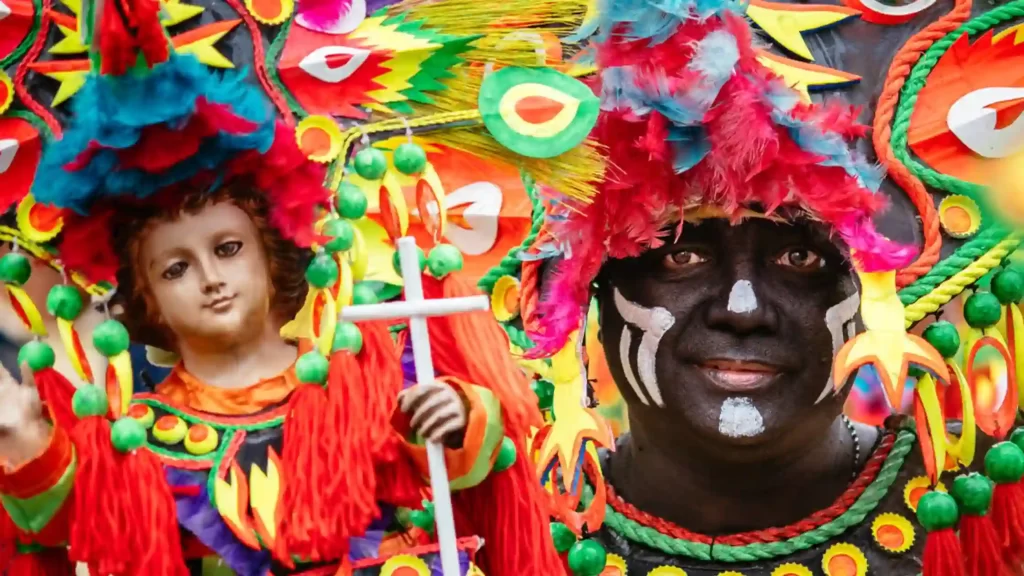
The History of the Ati Atihan Festival
The historical roots of Ati Atihan can be traced back to the 13th century, originating from a peaceful exchange between Aetas and Malays on Panay Island. The festival later incorporated Catholic elements during the time of Spanish colonization, including the veneration of baby Jesus, known as Santo Niño.
The term ‘Ati-atihan’ means ‘to be like Atis’ or ‘to make believe Atis.’ This mirrors the festival’s historical background as it pays tribute to the indigenous Ati people and their cultural traditions. Participants emulate the appearance of the Ati, wearing dark makeup as a gesture of appreciation and respect, thereby dressing up in tribal finery atmosphere during the festival.
More than just a festival, Ati Atihan:
serves as a testament to the harmonious relationship between the Aetas and Malays
pays homage to the rich cultural heritage of the indigenous Ati people
embodies the Filipino spirit of unity and celebration.
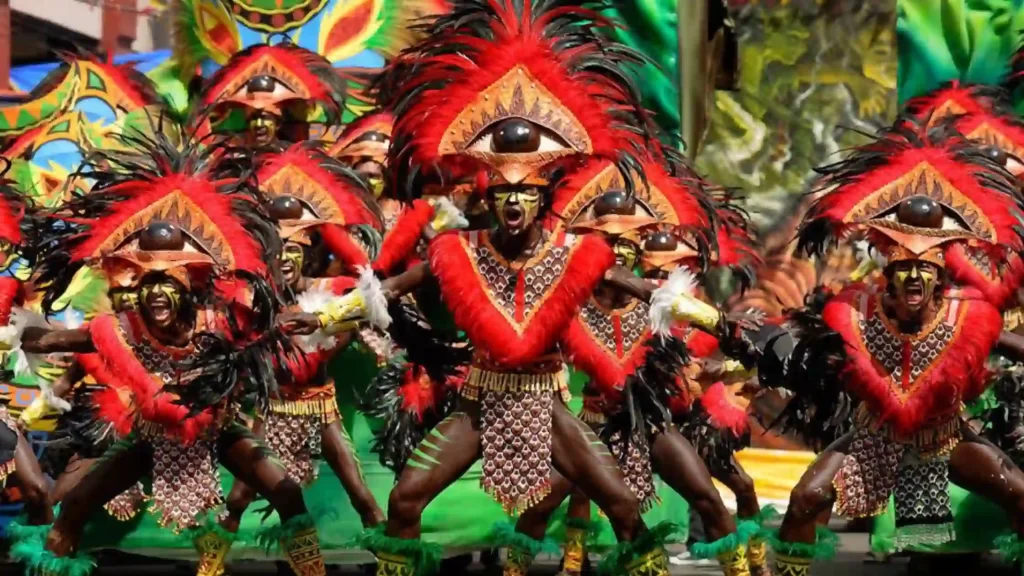
Ati Atihan's Vibrant Visuals: Costumes and Parades
Ati Atihan’s costumes are a vibrant tapestry of colors and intricate designs, embodying the essence of the festival’s visual splendor. Participants adorn themselves in native attire, meticulously handcrafted and inspired by traditional Ati clothing, symbolizing their homage to the indigenous Ati culture. These costumes, often made from woven fabrics, are accentuated with bright hues like red, yellow, green, and blue, and embellished with beads, feathers, and other decorative elements, adding to their festive allure.
The creation of these elaborate costumes, a labor of love and dedication by the local community, can take several weeks or months, showcasing their deep commitment to preserving and celebrating their cultural heritage. These costumes are not just attire but a vibrant expression of the festival’s spirit, offering a visual feast for both participants and spectators. The parade of these colorful, indigenous costumes stands out as a festival highlight, contributing significantly to the visual richness of the celebrations and cementing Ati Atihan’s status as one of the oldest and most visually captivating festivals in the Philippines.
Ati Atihan Celebrations: Week-Long Festivities Explained
Ati Atihan is more than just a day-long event; it’s a week-long celebration. The streets of Kalibo will be bustling with continuous festivities, reaching their climax on the third Sunday of the month.
The festival week is filled with a series of themed parades featuring floats, dancing groups, and marching bands. These parades, taking place every weekday afternoon, encourage spectators to join the vibrant procession and immerse themselves in the festivities. The energy of the festival intensifies throughout the week, culminating in a grand spectacle on Sunday.
This festivity is also observed in Boracay every second week of January. Given Boracay’s status as a tourist hotspot, the Ati Atihan festival there often includes beach parties and other tourist-friendly activities, offering a unique blend of traditional culture and modern entertainment.
As evening descends, the festival atmosphere remains electrified with excitement. Participants can look forward to engaging in lively festivities and snake-dancing at Magsaysay Park every night. The renowned street dancing commences on Friday and continues throughout the weekend, keeping the spirit of the festival alive well into the late hours.
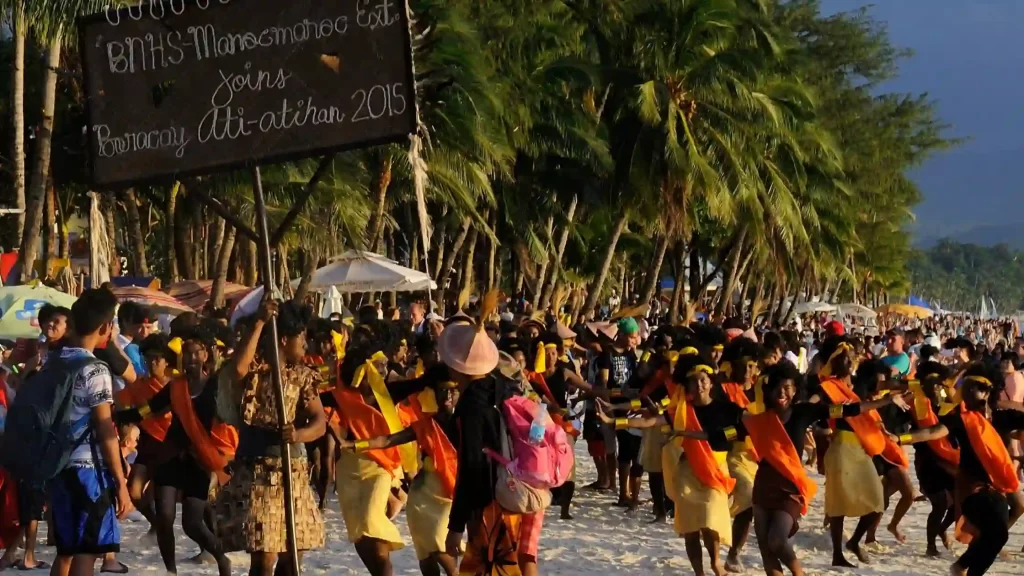
Traditions and Rituals: The Heart of Ati Atihan
Ati Atihan, the oldest festival, has its core woven with a rich tapestry of traditions and rituals, passed down through countless generations. The festival is deeply connected to these customs, blending indigenous practices with the Catholic veneration of Santo Niño, creating a unique cultural phenomenon and the biggest celebration in the region.
The Ati Atihan Festival pays tribute to the indigenous Ati people of the Philippine island of Panay and their cultural traditions that have a history of over 800 years. Events such as the community mass are an integral part of the festivities, showcasing the locals’ deep faith and community spirit.
The festival’s significance was further enhanced when the Philippines fell under Spanish rule, integrating devotion to Santo Niño into the indigenous festivities. This blend of indigenous customs and Catholic faith is what makes Ati Atihan a unique cultural experience that captivates both locals and tourists alike.
Ati Atihan Beats: Music and Merrymaking
The formal opening mass of the Ati-Atihan Festival is brought to life with rhythmic beats that significantly enhance the festival’s vibrancy. The music, a defining element of the celebration, features the distinctive cadence of bass drums and the resonant rhythm created by the clinking of metals and stones against bottles. This unique blend of sounds provides a pulsating backdrop to the processions and dance performances, injecting a dynamic energy into the festivities.
With over 80 groups performing, the festival boasts a diverse array of music that contributes to a lively and celebratory atmosphere. This variety not only energizes participants but also captivates spectators, enriching the overall ambiance of the festival. The music, an essential component of Ati-Atihan, encompasses traditional Filipino tunes that are upbeat and cheerful, perfectly encapsulating the festive spirit. Throughout the celebration, local musicians offer live performances, ensuring that there is always an opportunity to enjoy great tunes. These performances invite attendees to dance and sing along, further elevating the joyous mood of the festival.
Experience Ati Atihan: A Guide to Participation
One of the most exciting aspects of Ati Atihan is the opportunity for visitors to actively participate in the festival. Tourists are encouraged to fully immerse themselves in the local culture, joining the locals in dancing, singing, and celebrating the vibrant Filipino culture.
Participants have the unique opportunity to learn various traditional dances, such as the Ati-Atihan movement, which involves an uncomplicated single-forward step-tap sequence. This simple yet engaging dance allows everyone, regardless of their dance skills, to join in and celebrate.
Though participation is highly encouraged, visitors are urged to adhere to certain safety measures. These include being mindful of their alcohol intake, securing their valuables, and ensuring they have ample energy for the festivities. In doing so, participants can fully enjoy the festival while respecting the local customs and traditions.
Savoring Ati Atihan: Local Flavors and Delicacies
The Ati-Atihan Festival is a vibrant celebration that delights not just the eyes and ears but also caters to shoppers and food lovers. The festival grounds are dotted with numerous trade fairs and food parks, where visitors can immerse themselves in a variety of traditional clothing, crafts, and unique souvenirs, as well as indulge in the local culinary offerings.
This festival serves as a culinary journey, inviting attendees to experience the unique tastes of Kalibo and the Aklan province. Upon arrival, a must-visit is SAYLO, a trendy Aklanon eatery located just a few meters from the airport. Here, you can enjoy traditional dishes like Inubarang Manok, a savory blend of native chicken and ubad (core of Banana stalk) in coconut milk and lemongrass, and Linapay, a delightful dish of pounded fresh-water shrimp wrapped in taro leaves.
For meat lovers, Ramboy’s is the ideal spot, especially known for its liempo (pork belly), which is meatier, and juicier, and boasts a crunchier skin compared to what’s typically found in Manila. The servings are generous, making it perfect for sharing among three people.
During the festivity, don’t miss stopping by Bread & Butter, Kalibo’s most famous bakery. While they are renowned for their siopao, their cheeseburger is also a standout, reminiscent of the iconic chori burger from Boracay.
The Ati-Atihan Festival truly offers a feast for all senses, weaving together a rich tapestry of cultural, visual, auditory, and gastronomic experiences that are both diverse and enriching.

Ati Atihan Compared: How It Stands Out Among Philippine Festivals
In the Philippines, a country rich with vibrant festivals, Ati Atihan holds a special place. It’s more than just a celebration; it’s a profound homage to the indigenous Ati people and their culture, deeply intertwined with faith and community. This multi-sensory cultural event, dedicated to the Holy Santo Niño, distinguishes it from other Philippine festivals.
Ati Atihan is unique, with its indigenous animist tribute to ancestor spirits. Its ambiance and celebrations, featuring exceptional costumes, grand events, and rhythmic drumbeats, set it apart from festivals like Panagbenga and Kadayawan. These festivals are known for their own distinct flavors, but Ati Atihan’s vibrant and colorful atmosphere is unparalleled.
When compared to the Sinulog Festival, which also honors the Santo Niño and is celebrated in the Visayas, Ati Atihan stands out with its unique origins and cultural richness. Similarly, Dinagyang Festival, another spectacular event in honor of the Santo Niño, celebrated in Iloilo City, is known for its choreographed dances and elaborate costumes. However, Ati Atihan’s raw and authentic celebration style offers a different experience.
Both Sinulog and Dinagyang, like Ati Atihan, attract large crowds, showcasing the rich cultural diversity and spirited nature of the Filipino people. Each festival, with its unique characteristics, contributes to the rich tapestry of cultural celebrations in the Philippines.
Journey to Kalibo: Travel Tips for Ati Atihan Enthusiasts
For prospective attendees of the Ati Atihan Festival, various travel options are available to reach Kalibo. The primary method is flying from Manila to Kalibo, which takes about 1 hour and 8 minutes. Alternatively, visitors can fly to Caticlan, a nearby town, and then take a van or an L3 to Kalibo, a journey costing around 200 pesos per person and taking about 2-3 hours. For a more scenic approach, sea routes from Batangas to Caticlan Jetty Port are also an option, with a travel time of approximately 14 hours from Manila.
Whichever route you choose, your journey to Kalibo promises to be the start of an exciting and unforgettable cultural experience at the Ati Atihan Festival. For detailed instructions on getting to Kalibo, be sure to check our blog, “How to Get From Kalibo to Boracay” and “Kalibo Airport.”
Tips for Enjoying Boracay’s Ati-Atihan:
To reach Boracay, there are two primary travel options: by air or by sea. The most convenient air travel option is flying directly to Caticlan Airport, the nearest airport to Boracay. Alternatively, you can fly to Kalibo Airport and then take a bus or van to Caticlan. For those who prefer sea travel, ferries to Caticlan Jetty Port are available from various locations in the Philippines, followed by a short boat ride to Boracay.
Upon arrival on the island, tricycles and E-Trikes serve as the most common and affordable modes of local transportation. For greater independence, consider renting a bicycle or motorbike, but remember to adhere to local traffic rules. Additionally, make sure to familiarize yourself with the festival’s schedule to ensure you don’t miss any key events.
Expert Tips on Attending Ati-Atihan: Making the Most of the Festival
Attending the Ati-Atihan Festival in the Philippines is an unforgettable experience, enriched by vibrant celebrations and cultural immersion. To make the most of your visit, it’s crucial to plan your trip well in advance, particularly for accommodations and flights, due to the festival’s popularity. Comfort is key, so dress in lightweight, breathable clothing and comfortable shoes suitable for the warm, outdoor environment. Participate in the parades and dances to fully embrace the festival spirit, but always with respect for its cultural and religious significance. Make sure to familiarize yourself with the festival’s schedule to catch key highlights like the Sadsad dance and the grand procession. The local cuisine is a must-try, offering a taste of Filipino culinary delights.
For accommodations, consider these options:
In Kalibo:
Kalibo Hotel: Popular for its close proximity to Ati-Atihan venues, it offers comfortable rooms and top-notch service, ideal for enjoying the festival’s full experience.
La Esperanza Hotel: Strategically located for festival attendees, it provides a perfect mix of convenience and comfort, with easy access to parades and events.
RB Lodge Kalibo: A budget-friendly option, this lodge offers cozy accommodations right in the heart of Kalibo, perfect for immersing yourself in the festival vibe.
In Boracay:
Henann Garden Resort: Set on the stunning White Beach, this resort is a luxurious haven offering easy access to Boracay’s festival activities, along with beachside relaxation.
The Lind Boracay: Known for its elegance and Filipino hospitality, this resort is ideally located for a luxurious stay with easy festival access.
Boracay Haven Resort: A great mid-range choice, known for its prime location and friendly service, perfect for those looking to balance festival excitement with resort comfort.
Booking early is essential as accommodations in Kalibo and Boracay fill up quickly during the festival. Whether you choose the lively streets of Kalibo or the serene beaches of Boracay, these hotels promise a comfortable stay.
A critical note for travelers: Traffic during the Ati-Atihan Festival, especially in Kalibo, can be quite challenging. If you’re planning to catch a flight or have time-sensitive travel arrangements, it’s wise to allow extra time for travel. The roads can get congested, and finding transportation can be more difficult than usual. To mitigate these challenges, consider booking a transfer with MyBoracayGuide. They offer reliable and convenient transfer services that can help you navigate the busy festival period with ease. By arranging your transportation in advance through MyBoracayGuide, you can avoid the hassle of last-minute bookings and ensure a timely and stress-free journey to and from the festival. Planning for these contingencies with a trusted service like MyBoracayGuide will ensure a smoother and more enjoyable end to your Ati-Atihan experience.
Other tips to enhance your festival experience include dressing for comfort and culture, diving into the festivities, knowing the schedule, savoring local flavors, staying hydrated and healthy, capturing memories respectfully, being open to making connections, being environmentally conscious, and prioritizing safety. By following these tips, you’re set for a culturally rich and enjoyable Ati-Atihan experience.
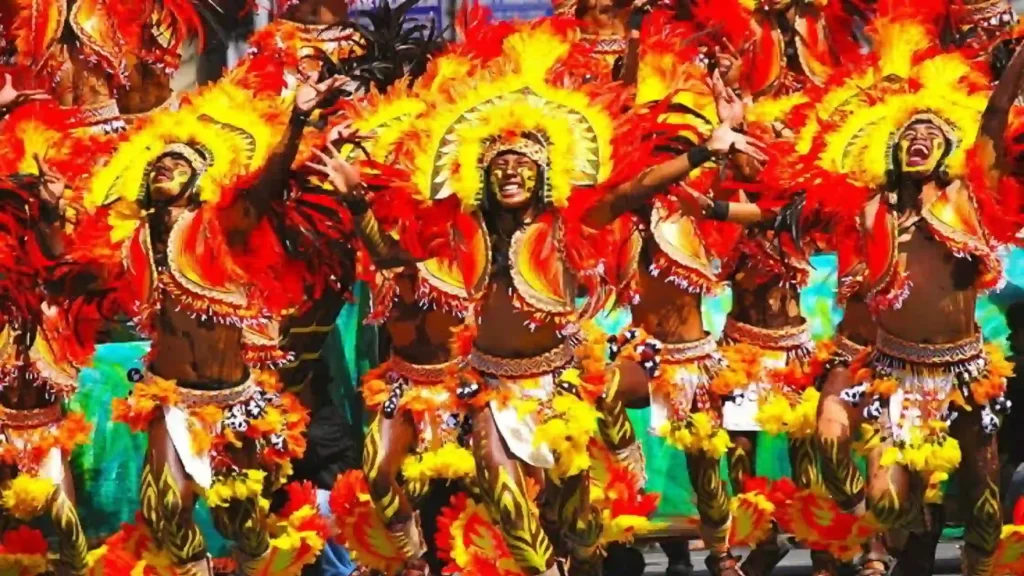
After a Long Day
Ati Atihan is not just a festival; it’s a vibrant celebration of Filipino culture, a testament to the rich cultural heritage of the indigenous Ati people, and a unique blend of indigenous customs and Catholic devotion. From its energetic parades and colorful costumes to its lively music and mouth-watering local delicacies, Ati Atihan offers a multi-sensory experience that captivates all who attend.
Whether you’re a first-time visitor or a seasoned festival-goer, Ati Atihan offers a unique opportunity to immerse yourself in the rich Filipino culture, join in the vibrant celebrations, and create unforgettable memories. So why not join us this January for the Ati Atihan Festival and experience the pulsating heart of Filipino culture for yourself?
Frequently Asked Questions (FAQs)
The Ati-Atihan Festival is celebrated to honor the Santo Nino (Infant Jesus) and to commemorate a peace pact between two warring tribes back in 1210. It is believed to be the oldest festival in the Philippines and celebrates the indigenous population of the country while honoring the Infant Jesus.
The festival costumes can be purchased from local costume shops, markets, or online stores that specialize in traditional clothing and accessories. It’s a good idea to look for stores or sellers that have a reputation for providing authentic and well-crafted costumes.
The Ati Atihan Festival is celebrated annually in the Philippines on every third Sunday of January in the town of Kalibo, Aklan, located in the Visayas region. The festival typically lasts for a week and includes various events, processions, dances, and rituals.
The Ati-Atihan festival in Aklan focuses on the ritual itself, while the Sinulog festival in Cebu emphasizes the historical aspects of the dance and the country’s embrace of Christian faith. Both festivals have their distinct cultural significance.
You can expect to see vibrant celebrations, colorful costumes, lively music, street parades, and traditional dances at Ati Atihan, reaching its peak on the third Sunday of January.


No Comments on Experience the Vibrant Ati Atihan Festival: Philippines’ Largest Street Parade